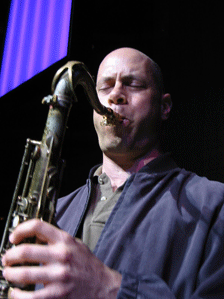
Saxophonist Walt Weiskopf's first-ever in-concert recording Walt Weiskopf Quartet: Live, issued earlier in the month on Colorado-based Capri Records, is special in another personal way. It's dedicated to drummer Tony Reedus, who died from a pulmonary embolism less than a year after this show was recorded in April 2008 on the campus of the University of South Carolina. He was just 49.
After learning of Reedus' passing, Weiskopf returned to the South Carolina show, part of the bi-annual North American Saxophone Alliance convention, and decided to release the music in honor of Reedus—an in-demand drummer who had worked over a lengthy career with jazz greats like Woody Shaw, Milt Jackson, Art Farmer, Mulgew Miller, Benny Golson, Freddie Hubbard and countless others.
Weiskopf and Reedus are joined on the date by pianist Renee Rosnes, who's released nine albums on the Blue Note label; and bassist Paul Gill, a longtime member of the Toshiko Akyoshi Jazz Orchestra. Both players sync up well with Weiskopf's tenor in terms of technical prowess and emotional delicacy. It's here, though, on a newly arranged take on Cole Porter's “Love for Sale," that Reedus gets his chance to shine for one of the final times.
After a merry statement of the theme by Weiskopf, Rosnes and Gill begin a quietly ruminative conversation—a perfect set up for Weiskopf's looming solo, which is by turns melodic, aggressive and inventive. But check out Reedus, who has begun to add a series of masterful shadings from behind the drum kit, each more complex and multilayered than the last. He sits simultaneously at the center, and on this song's edges—keeping time, but also pushing and pulling at Weiskopf, encouraging him to go further.
Reedus subsequently settles into a snappy, if more conventional stride for Rosnes' solo, but comes alive at each pause—filling with an exuberant abandon. As Rosnes begins to rush toward the restatement of the theme, Reedus speeds up too, then begins this thrilling call-and-response with a returning Weiskopf. He delivers a thunderous final splash of color and sound before falling back into an unfussy rhythm, providing understated structure for Weiskopf again through the song's completion.
It's simply a virtuoso performance, one of both individual achievement and supportive cohesion—and, of course, a new reminder of the lost brilliance of Tony Reedus.
After learning of Reedus' passing, Weiskopf returned to the South Carolina show, part of the bi-annual North American Saxophone Alliance convention, and decided to release the music in honor of Reedus—an in-demand drummer who had worked over a lengthy career with jazz greats like Woody Shaw, Milt Jackson, Art Farmer, Mulgew Miller, Benny Golson, Freddie Hubbard and countless others.
Weiskopf and Reedus are joined on the date by pianist Renee Rosnes, who's released nine albums on the Blue Note label; and bassist Paul Gill, a longtime member of the Toshiko Akyoshi Jazz Orchestra. Both players sync up well with Weiskopf's tenor in terms of technical prowess and emotional delicacy. It's here, though, on a newly arranged take on Cole Porter's “Love for Sale," that Reedus gets his chance to shine for one of the final times.
After a merry statement of the theme by Weiskopf, Rosnes and Gill begin a quietly ruminative conversation—a perfect set up for Weiskopf's looming solo, which is by turns melodic, aggressive and inventive. But check out Reedus, who has begun to add a series of masterful shadings from behind the drum kit, each more complex and multilayered than the last. He sits simultaneously at the center, and on this song's edges—keeping time, but also pushing and pulling at Weiskopf, encouraging him to go further.
Reedus subsequently settles into a snappy, if more conventional stride for Rosnes' solo, but comes alive at each pause—filling with an exuberant abandon. As Rosnes begins to rush toward the restatement of the theme, Reedus speeds up too, then begins this thrilling call-and-response with a returning Weiskopf. He delivers a thunderous final splash of color and sound before falling back into an unfussy rhythm, providing understated structure for Weiskopf again through the song's completion.
It's simply a virtuoso performance, one of both individual achievement and supportive cohesion—and, of course, a new reminder of the lost brilliance of Tony Reedus.


























